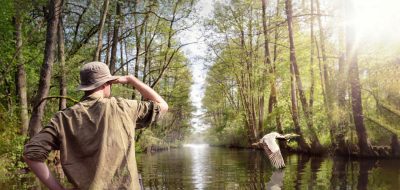By Bob Difley
Spring is here. Almost. The time when we look forward to the end of winter. When desert wildflowers poke through the barren sand and gravelly washes. When the rain turns from all day, gloomy downpours to flighty spring showers punctuated with rays of the unfamiliar sun. When you finally bury the snow shovel in the back of the garage behind skies and tire chains. And when migratory birds, sensing whatever it is that that triggers their urges, set off from their winter havens for their summer nesting and breeding grounds.
The spring migration follows the four major flyways, the Pacific, Central, Mississippi, and Atlantic, though these flyways almost touch on their borders. The spring migration is when birds are bursting out with their colorful breeding plumage, the bright colors that hopefully will attract a mate. Birds during this time are also very vocal, for the same reason. They sing away at the top of their lungs for exhausting periods, since available females are fussy and often take a long time to make up their minds. Female birds, that is.
She has to be fussy. After all, her selection will pass on his genes, which will determine the survival and future breeding capabilities of her offspring. Survival of the fittest. So a lot is at stake, not to mention having to fatten up after the arduous flight of hundreds, if not thousands, of miles on the migration, with little rest and not much time to forage for food.
But if it’s a serious time for birds, it’s an enjoyable time for RVers who have discovered the joys of birdwatching. One of America’s fastest growing forms of outdoor recreation, birdwatching fits with RVing like campfires and pot lucks. Birds are creatures of regional habits. You most likely won’t find a roseate spoonbill in Oregon, or a California condor in Cleveland. So wherever your RV travels take you, you will find new and different species to add to your life list.
Birdwatching fits into these turbulent financial times also, as it costs little to nothing to pursue, can be done anywhere, provides exercise, and gets you out enjoying nature. It requires little equipment to get started and no entry fees, greens fees, user fees, or other charges necessary to pursue, as some other outdoor activities do. A light-weight pair of binoculars (folding ones will fit in your pocket) and a field guide book or regional guide is all you need. You can pick up a free bird list from local visitor centers and have a head start on what you can expect to see, and you will eliminate possible false identifications of birds that are not present in the area.
Just lace up your hiking boots and head out–anywhere you camp there will be feathered subjects for you to watch and enjoy. Watching the spring activities of birds is especially enjoyable, as they vie for mates, build nests, chase predators from their nests, and raise babies. And if you are staying in your campsite for more than a few days, hang out a feeder and see what comes to visit. To learn more about birdwatching, plan on attending my Beaks & Feathers: An RVers Guide to Birdwatching class at The Rally in Albuquerque in April.










Pingback: sma